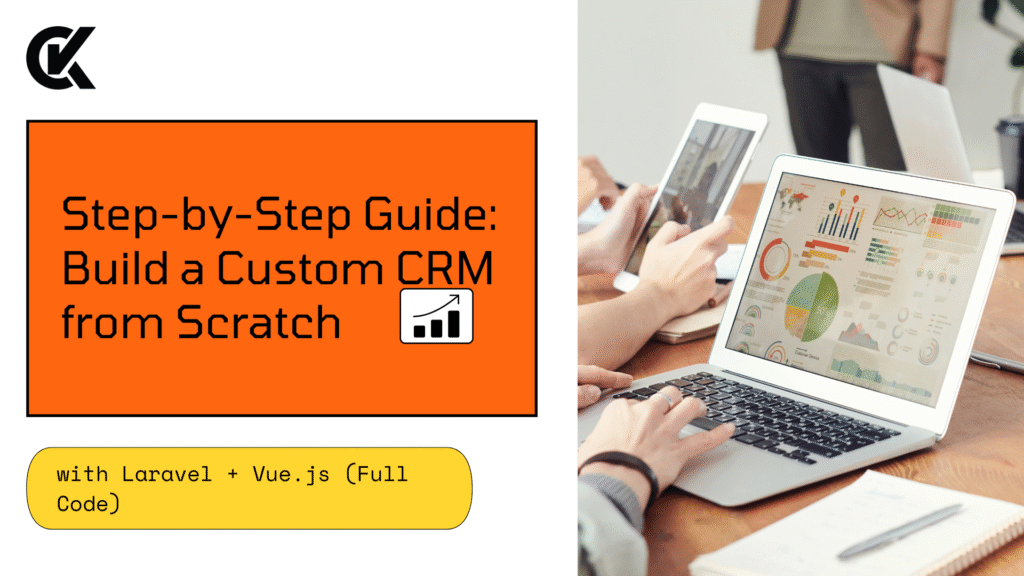Table of Contents
1. What is a Custom CRM and Why Build One?
A CRM (Customer Relationship Management) tool helps businesses manage their interactions with existing and potential customers. Popular options like HubSpot, Salesforce, and Zoho CRM are great—but they’re often overkill, expensive, or inflexible.
Custom CRMs give businesses:
- Full control of features
- Seamless integration with existing tools
- Cost-effective long-term scalability
- Ownership of sensitive customer data
2. Why Laravel + Vue.js?
- Laravel is a powerful PHP framework offering built-in routing, ORM (Eloquent), authentication, and more.
- Vue.js is a lightweight frontend framework ideal for building reactive, component-driven UIs.
- They’re a perfect match for Single Page Applications (SPAs) and API-driven development.
3. Tools & Tech Stack Overview
| Tool | Purpose |
|---|---|
| Laravel 11 | Backend API, DB, Auth |
| Vue 3 + Vite | Frontend UI Components |
| Axios | API Communication |
| MySQL | Database |
| Tailwind CSS | Styling |
| Postman | API Testing |
| Laravel Sanctum | API Authentication |
4. Project Structure & Setup
📥 Install Laravel
composer create-project laravel/laravel crm-app
cd crm-app
php artisan serve⚙️ Configure .env
DB_DATABASE=crm
DB_USERNAME=root
DB_PASSWORD=Create the crm database in MySQL.
5. Backend: Laravel API Development
🛠️ a) Create Customer Model & Migration
php artisan make:model Customer -mNow edit the migration:
public function up()
{
Schema::create('customers', function (Blueprint $table) {
$table->id();
$table->string('name');
$table->string('email')->unique();
$table->string('phone')->nullable();
$table->text('notes')->nullable();
$table->timestamps();
});
}Run the migration:
php artisan migrate📦 b) Customer Controller
php artisan make:controller API/CustomerController --apiController Logic
namespace App\Http\Controllers\API;
use App\Http\Controllers\Controller;
use Illuminate\Http\Request;
use App\Models\Customer;
class CustomerController extends Controller
{
public function index() {
return response()->json(Customer::all(), 200);
}
public function store(Request $request) {
$validated = $request->validate([
'name' => 'required|string',
'email' => 'required|email|unique:customers,email',
]);
$customer = Customer::create($validated + $request->only(['phone', 'notes']));
return response()->json($customer, 201);
}
public function show($id) {
return response()->json(Customer::findOrFail($id));
}
public function update(Request $request, $id) {
$customer = Customer::findOrFail($id);
$customer->update($request->all());
return response()->json($customer);
}
public function destroy($id) {
Customer::destroy($id);
return response()->json(['message' => 'Customer deleted']);
}
}Update the Model
protected $fillable = ['name', 'email', 'phone', 'notes'];🌐 c) API Routes
Update routes/api.php:
use App\Http\Controllers\API\CustomerController;
Route::apiResource('customers', CustomerController::class);🎨 6. Frontend: Vue 3 + Vite Setup
🧰 a) Install Vue 3
npm install
npm install vue@next vue-router@4 axios
npm run devresources/js/app.js
import { createApp } from 'vue';
import App from './App.vue';
createApp(App).mount('#app');🔲 b) Basic Component: CustomerList.vue
<template>
<div>
<h2 class="text-xl font-bold mb-4">Customer List</h2>
<ul>
<li v-for="customer in customers" :key="customer.id" class="mb-2">
{{ customer.name }} – {{ customer.email }}
<button @click="deleteCustomer(customer.id)" class="text-red-600">Delete</button>
</li>
</ul>
</div>
</template>
<script>
import axios from 'axios'
export default {
data() {
return {
customers: []
}
},
mounted() {
this.getCustomers()
},
methods: {
getCustomers() {
axios.get('/api/customers').then(res => {
this.customers = res.data
})
},
deleteCustomer(id) {
axios.delete(`/api/customers/${id}`).then(() => this.getCustomers())
}
}
}
</script>🧩 App.vue
<template>
<div class="max-w-4xl mx-auto p-6">
<h1 class="text-3xl font-bold mb-6">Custom CRM</h1>
<CustomerList />
</div>
</template>
<script>
import CustomerList from './components/CustomerList.vue'
export default {
components: { CustomerList }
}
</script>
🔐 7. Authentication with Laravel Sanctum
Install Laravel Sanctum:
composer require laravel/sanctum
php artisan vendor:publish --provider="Laravel\Sanctum\SanctumServiceProvider"
php artisan migrateIn api.php:
Route::middleware('auth:sanctum')->group(function () {
Route::apiResource('customers', CustomerController::class);
});🎨 8. UI Enhancements with Tailwind CSS
Install Tailwind:
npm install -D tailwindcss
npx tailwindcss initAdd Tailwind to resources/css/app.css:
@tailwind base;
@tailwind components;
@tailwind utilities;Update Vite config and re-run:
npm run devYour CRM now looks clean, responsive, and modern.
✅ 9. Testing the Custom CRM
Use Postman or Vue UI:
- Create a customer → POST
/api/customers - Read all customers → GET
/api/customers - Update customer → PUT
/api/customers/{id} - Delete customer → DELETE
/api/customers/{id}
🚀 10. Future Improvements
To scale this CRM further:
- Add search, filters, pagination
- Export customer data to CSV/PDF
- Add email/SMS integrations
- Add user roles: admin, staff, sales
- Build dashboards with charts (Chart.js)
🧠 11. Conclusion
By building a CRM from scratch using Laravel + Vue.js, you gain full control, flexibility, and scalability. This is ideal for teams who want software tailored to their operations—no extra features, no subscriptions, no compromises.
Whether you’re a dev building your own tool or an agency like Kavcom Expert creating solutions for clients—this stack delivers.
📢 Want to Build a CRM for Your Team?
At Kavcom Expert, we build custom CRMs, dashboards, and SaaS products for businesses in the US and globally. Contact us for tailored development.







Top 10 Tools Every Web Developer Should Know in 2025 - Kavcom Expert
July 10, 2025 at 4:12 pm[…] collaborative platforms reshaping how we build for the web. I’ve put together a list of the top 10 tools every web developer should know this year, based on their impact, ease of use, and ability to streamline projects. […]